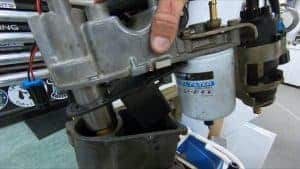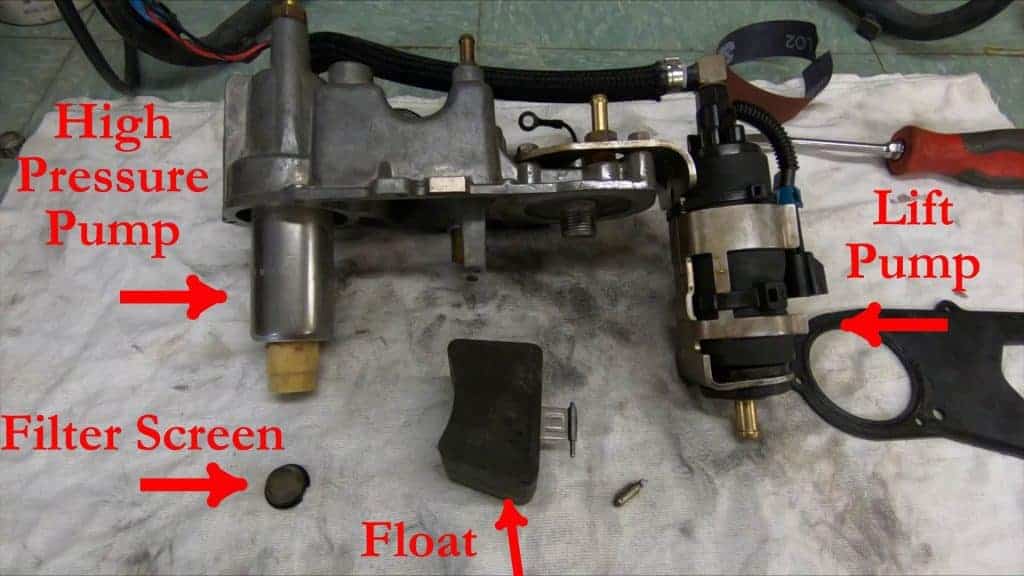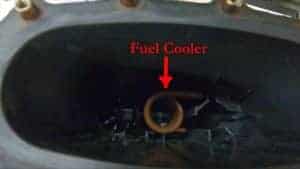When you spend a lot of time out on the water using your boat, there tend to be problems that occur. One of the most common problems that happen, is fuel problems.
You might find yourself needing to do some work on your fuel system, but don’t know where to start. After talking to some people and researching on Google. You find you need to check your VST or FSM!
What is an Outboard FSM or VST? VST stands for Vapor Separator Tank, and FSM stands for Fuel Supply Module. These contain the high-pressure fuel pump that builds your engine’s fuel pressure.
Here are a few things to know about the Vapor Separator Tank and the Fuel Supply Module and how they operate.
Why the Two Names
The most common name or older name is VST. Almost all Outboard engine manufacturers at some point in time called this the VST. In fact, most manufacturers still do.
When Mercury Marine came out with the Verado engine, they changed the name to Fuel Supply Module.
The FSM has different electric fuel pumps, float switches, and pressure regulators inside it. They have made more design changes that we’ll talk about later.
So outside of Mercury’s FSM, VST is a more commonly known name to more people.
What’s Inside a VST?
The inside of most VST’s are a High-Pressure Fuel Pump with a filtering screen. There is a float that will shut off the fuel flow once the VST is full of fuel. Sometimes, there is the Low-Pressure Fuel Pump or the Lift Pump.
The lift pump is incorporated either inside or outside of the VST depending on the make and model of the engine.
Depending on the engine brand and model. Some VSTs also have the fuel pressure regulator located inside the VST.
At the top of the VST, there is usually an overflow or vent. So, if the lift pump fails on the VST it has the ability to get rid of the fuel the pump is pumping into it.
What’s Inside an FSM?
Inside the FSM we have the Lift Pump, High-Pressure Pump, Float Switch, and the Fuel Pressure Regulator. All of these with the exception of the pressure regulator are electronically controlled by the engine’s PCM. (Propulsion Control Module)
Both of the Fuel Pumps have small filtration screens on the input side of the pump. Which can be cleaned. The high-pressure pump screen can be removed from the pump and cleaned. However, the low-pressure pump’s screen is built into the pump and can not be.
How Does the VST Work?
Both the FSM and the VST operate in a similar fashion with a couple of different variations.
Engines that utilize an older style VST have an incorporated fuel system and diaphragm fuel pump. This lift pump helps to assist in sucking fuel from the fuel tank and getting it to the VST.
Once the fuel has been fed to the VST, the VST will fill up until the float rises to shut off the intake side of the fuel system. From the lift pump.
With the VST full of fuel, the high-pressure pump sucks the fuel that is inside of the VST and pressurizes it, pushing it to the fuel rails. There is usually a pressure regulator somewhere on the output side of the high-pressure pump, somewhere down the fuel line.
The pressurized fuel rails have the fuel injectors attached to it where they are controlled to open and close at the proper timing, squirting the fuel into the cylinder. The injector’s job is to take the pressurized fuel and atomize it when it squirts it into the cylinder.
That simply means that it turns it into sort of a mist of fuel as opposed to a stream of fuel. This makes for easy combustion when the spark plug ignites. Thus, an explosion that drives the piston down, keeping the engine running.
How Does the FSM Work?
The FSM that Mercury uses is a little more complicated. Once you understand it though, it is a pretty simple system. It operates in the same fashion as the VST, as far as the fuel rails and injectors are concerned. It is also completely electronically controlled by the PCM.
The FSM has the lift pump incorporated into it. The low-pressure pump has a screen built into it and it sucks the fuel from the fuel tank into the FSM.
The PCM tells the lift pump when to turn on using the readings that it gets from the float switch and two other sensors on the engine. There is a Purge Valve and the Vent Canister Switch.
If the PCM sees readings that the Purge Valve is OPEN, the Vent Canister Switch is LOW, and that the FSM Float Switch is LOW, it will turn on the lift pump for a certain duration of time.
If the FSM float switch does not change positions after this time, it will turn off the lift pump and give a Lift Pump Time Out Code. Usually, the lift pump is not getting any fuel from the boat when this happens.
When everything is working properly. The FSM float switch will change from LOW to HIGH and it will turn off the lift pump leaving the FSM full of fuel. There is a crankcase-driven pressure regulator inside of the FSM that regulates the pressure inside of the FSM.
With the FSM full of fuel, the high-pressure pump sucks the fuel up and pressurizes the rails. Allowing the engine to run normally.
The FSM also has a fuel cooler built into the housing, which runs water through a copper tube, cooling down the fuel!
FSM Upgrades
There have been some changes to the FSM that came out around 2012 or so. The new FSMs no longer have the float switches inside and only have two wires, which run both pumps all of the time.
The FSM fits all of the new Verados, the new V-6 and V-8 models, along with certain Mercruiser engines. They are basically using the same FSM for all of the larger engine models that they make.
If you want to know more about Mercury FSMs. Here is a link to our video on completely Disassembling an FSM that has the float switch inside:
Understanding How an Engines Fuel System Works
Having a good understanding on how an engine’s fuel system operates is a crucial part of working on a VST or FSM. Without a basic understanding of the fuel system, you are opening yourself up to a world of opportunities you DON’T want!
If you are going to be working on either a VST or FSM. I would suggest doing some good research on the exact engine you have before embarking on that adventure.
Neither of these systems are that complicated, but if it’s all new to you, then it can be complicated and overwhelming. After a little bit of reading and a couple of YouTube Videos though, you should have no trouble fixing your engine and getting back out on the water.
Check Us Out!
We hope that this has been insightful and allowed you to understand a little bit more about outboard FSMs and VSTs!
If you have more questions or want to learn more about your boat and its different systems. You should consider joining our Boating Academy where we have created HUNDREDS of video courses teaching you basically everything about your boat!
There are also even more helpful videos on our Youtube channel where we create even more boating videos!
You can also save some money by using our coupons when you need to buy stuff from your boat by using any of these coupons here at Partsvu!
And if you would like to support us to continue bringing you great content, please click the link below to Amazon where we get a commission from anything you are already going to buy! Click Here To Amazon!
Here are some other super helpful articles that you might find interesting!
If you have been into your VST or FSM, tell us about it below! If you know of some helpful tips, don’t be shy, and share with us so we can help more people spend more time on the water than stuck at the dock.



